Recent Advances in Polysaccharides from Cornus officinalis: Extraction, Purification, Structural Features, and Bioactivities
Abstract
1. Introduction
2. Extraction and Purification
2.1. Extraction
2.1.1. Supercritical Fluid Extraction (SFE)
2.1.2. Aqueous Two-Phase Extraction (ATPE)
2.1.3. Microwave-Assisted Aqueous Two-Phase Extraction (MATPE)
2.1.4. Ultrasonic-Assisted Aqueous Two-Phase Extraction (UAATPE)
2.1.5. Ultrasonic Enhanced Compound Enzyme Auxiliary Extraction (UCEA)
2.1.6. Ultrasonic-Microwave Synergistic Extraction (UMSE)
2.2. Purification
3. Structural Features and Physicochemical Properties
3.1. Monosaccharide Composition
3.2. Average Molecular Weight (Mw)
3.3. Chemical Structures
3.4. Chemical Modification
4. Biological Activities
4.1. Antioxidant Activity
4.2. Antitumor Activity
4.3. Immunomodulatory Activity
4.4. Other Bioactivities
5. Conclusions and Future Perspectives
Author Contributions
Funding
Institutional Review Board Statement
Informed Consent Statement
Data Availability Statement
Conflicts of Interest
References
- Fan, Q.; Cheng, X.B.; Rong, L.; Zhang, C.X. Research progress on chemical constituents, bioactivities, formula applications and quality control of Cornus officinalis. Nat. Prod. Res. Dev. 2020, 32, 1244–1258. [Google Scholar] [CrossRef]
- Yang, X.L.; Sun, H.Q.; He, C.F.; Lu, L.S.; Kang, J.F. Analysis of amino acid composition and nutritional evaluation of Corni Fructus from different habitats. J. Food Saf. Qual. 2022, 13, 7200–7209. [Google Scholar] [CrossRef]
- Peng, Z.C.; Wang, Y.M.; He, J.; Zhang, J.; Pan, X.G.; Ye, X.S.; Zhang, W.K.; Xu, J.K. Chemical constituents and their antioxidant and anti-inflammatory activities from edible Cornus officinalis fruits. Eur. Food Res. Technol. 2022, 248, 1003–1010. [Google Scholar] [CrossRef]
- Li, M.L.; Wang, P.; Yin, C.; Zan, J.F.; Yang, K.; Chen, L.L.; Liu, J.F. Pharmacodynamic evaluation and mechanism study of Corni Fructus polysaccharide on anti-aging of Caenorhabditis elegans. J. Food Saf. Qual. 2022, 13, 6996–7003. [Google Scholar] [CrossRef]
- Gao, X.; Liu, Y.; An, Z.; Ni, J. Active components and pharmacological effects of Cornus officinalis: Literature review. Front. Pharmacol. 2021, 12, 633447–633460. [Google Scholar] [CrossRef]
- Yang, L.Y.; Wang, Z.F.; Huang, L.J. Isolation and structural characterization of a polysaccharide FCAP1 from the fruit of Cornus officinalis. Carbohydr. Res. 2010, 345, 1909–1913. [Google Scholar] [CrossRef] [PubMed]
- Shang, Z.H.; Hou, Y.D.; Wang, L.L.; Cui, Y.X.; Wu, M.X.; Chen, S.Q. Research Progress on Extraction and Separation, Chemical Structure and Biological Activity of Polysaccharides from Shanzhuyu (Corni Fructus). Chin. Arch. Tradit. Chin. Med. 2024, 42, 233–239. [Google Scholar] [CrossRef]
- Chen, K.; Li, J.; Chen, K.; Hou, X.; Mai, H.; Xue, X. The mechanism of Cornus officinalis Total glycosides and Cornus polysaccharide on myocardial protection in rats with acute myocardial infarction. Chin. Med. 2016, 7, 45–54. [Google Scholar] [CrossRef]
- Shi, L. Bioactivities, isolation and purification methods of polysaccharides from natural products: A review. Int. J. Biol. Macromol. 2016, 92, 37–48. [Google Scholar] [CrossRef]
- Li, J.; Huang, G. Extraction, purification, separation, structure, derivatization and activities of polysaccharide from Chinese date. Process Biochem. 2021, 110, 231–242. [Google Scholar] [CrossRef]
- Bao, H.; Wang, Y.; Huang, Y.; Zhang, Y.; Dai, H. The Beneficial Role of Polysaccharide Hydrocolloids in Meat Products: A Review. Gels 2025, 11, 55. [Google Scholar] [CrossRef]
- Rong, L.; Shen, M.; Zhang, Y.; Yu, H.; Xie, J. Food Polysaccharides and Proteins: Processing, Characterization, and Health Benefits. Foods 2024, 13, 1113. [Google Scholar] [CrossRef]
- Deng, J.; Zhu, E.-Q.; Xu, G.-F.; Naik, N.; Murugadoss, V.; Ma, M.-G.; Guo, Z.; Shi, Z.-J. Overview of renewable polysaccharide-based composites for biodegradable food packaging applications. Green Chem. 2022, 24, 480–492. [Google Scholar] [CrossRef]
- Olivito, F.; Jagdale, P.; Oza, G. Direct Production of Furfural from Fructose Catalyzed by Iron (III) Sulfate Using a Simple Distillation Apparatus. ACS Sustain. Chem. Eng. 2023, 11, 17595–17599. [Google Scholar] [CrossRef]
- Luan, F.; Zou, J.B.; Zhang, X.F.; Zeng, J.S.; Peng, X.; Li, R.Y.; Shi, Y.J.; Zeng, N. The extraction, purification, structural features, bioactivities, and applications of Schisandra chinensis polysaccharides: A review. Int. J. Biol. Macromol. 2024, 262, 130030–130050. [Google Scholar] [CrossRef] [PubMed]
- Borjigin, G.; Wei, F.; Jiang, S.; Li, Q.; Yang, C. Extraction, purification, structural characterization and biological activity of polysaccharides from Fritillaria: A review. Int. J. Biol. Macromol. 2023, 242, 124817–124831. [Google Scholar] [CrossRef] [PubMed]
- Li, Z.; Zhang, Z.; Ding, J.; Li, Y.; Cao, G.; Zhu, L.; Bian, Y.; Liu, Y. Extraction, structure and bioactivities of polysaccharide from root of Arctium lappa L.: A review. Int. J. Biol. Macromol. 2024, 265, 131035–131055. [Google Scholar] [CrossRef]
- Wang, J.; Zhang, A.Y.; Hu, Y.L.; Yuan, X.; Qiu, Y.H.; Dong, C.H. Polysaccharides from fructus corni: Extraction, purification, structural features, and biological activities. Carbohydr. Res. 2024, 538, 109072–109082. [Google Scholar] [CrossRef]
- Xue, H.K.; Wang, W.L.; Bian, J.Y.; Gao, Y.C.; Hao, Z.T.; Tan, J.Q. Recent advances in medicinal and edible homologous polysaccharides: Extraction, purification, structure, modification, and biological activities. Int. J. Biol. Macromol. 2022, 222, 1110–1126. [Google Scholar] [CrossRef]
- Liu, Z.; Liu, Y.; Man, S.L.; Guo, L.Q.; Li, X.; Gao, W.Y. Functional factors, nutritional value and development strategies of Cornus:A review. Trends Food Sci. Technol. 2023, 139, 104121–104138. [Google Scholar] [CrossRef]
- Chen, H.G.; Zhou, X.; Zhang, J.Z. Optimization of enzyme assisted extraction of polysaccharides from Astragalus membranaceus. Carbohydr. Polym. 2014, 111, 567–575. [Google Scholar] [CrossRef] [PubMed]
- Li, L.; Xie, J.C.; Zhang, Z.M.; Xia, B.H.; Li, Y.M.; Lin, Y.; Li, M.J.; Wu, P.; Lin, L.M. Recent advances in medicinal and edible homologous plant polysaccharides: Preparation, structure and prevention and treatment of diabetes. Int. J. Biol. Macromol. 2024, 258, 128873–128900. [Google Scholar] [CrossRef]
- You, Q.H.; Yin, X.L.; Zhao, Y.P. Enzyme assisted extraction of polysaccharides from the fruit of Cornus officinalis. Carbohydr. Polym. 2013, 98, 607–610. [Google Scholar] [CrossRef]
- Chen, M.J.; Li, D.; Meng, X.W.; Sun, Y.; Liu, R.; Sun, T.D. Review of isolation, purification, structural characteristics and bioactivities of polysaccharides from Portulaca oleracea L. Int. J. Biol. Macromol. 2024, 257, 128565–128582. [Google Scholar] [CrossRef]
- Liu, Y.; Shi, Y.J.; Zou, J.B.; Zhang, X.F.; Zhai, B.T.; Guo, D.Y.; Sun, J.; Luan, F. Extraction, purification, structural features, biological activities, modifications, and applications from Taraxacum mongolicum polysaccharides: A review. Int. J. Biol. Macromol. 2024, 259, 129193–129220. [Google Scholar] [CrossRef] [PubMed]
- Lu, X. Changes in the structure of polysaccharides under different extraction methods. eFood 2023, 4, e82. [Google Scholar] [CrossRef]
- Jiao, X.; Li, F.; Zhao, J.; Wei, Y.; Zhang, L.; Wang, H.; Yu, W.; Li, Q. Structural diversity and physicochemical properties of polysaccharides isolated from pumpkin (Cucurbita moschata) by different methods. Food Res. Int. 2023, 163, 112157–112169. [Google Scholar] [CrossRef]
- Herrero, M.; Mendiola, J.A.; Cifuentes, A.; Ibáñez, E. Supercritical fluid extraction: Recent advances and applications. J. Chromatogr. A 2010, 1217, 2495–2511. [Google Scholar] [CrossRef]
- Tan, J.Q.; Cui, P.S.; Ge, S.Q.; Cai, X.; Li, Q.; Xue, H.K. Ultrasound assisted aqueous two-phase extraction of polysaccharides from Cornus officinalis fruit: Modeling, optimization, purification, and characterization. Ultrason. Sonochem. 2022, 84, 105966–105978. [Google Scholar] [CrossRef]
- Du, L.P.; Cheong, K.-L.; Liu, Y. Optimization of an aqueous two-phase extraction method for the selective separation of sulfated polysaccharides from a crude natural mixture. Sep. Purif. Technol. 2018, 202, 290–298. [Google Scholar] [CrossRef]
- Lin, Y.; Zeng, H.; Wang, K.; Lin, H.; Li, P.; Huang, Y.; Zhou, S.; Zhang, W.; Chen, C.; Fan, H. Microwave-assisted aqueous two-phase extraction of diverse polysaccharides from Lentinus edodes: Process optimization, structure characterization and antioxidant activity. Int. J. Biol. Macromol. 2019, 136, 305–315. [Google Scholar] [CrossRef]
- Hatti-Kaul, R. Aqueous two-phase systems: A general overview. Mol. Biotechnol. 2001, 19, 269–277. [Google Scholar] [CrossRef] [PubMed]
- Xue, H.; Wang, W.; Wu, J.; Xie, K.; Ge, S.; Tan, J. Ultrasound assisted aqueous two-phase extraction of polysaccharides from corn stigma: Process optimization, structure characterization, and immunomodulatory activity. Innov. Food Sci. Emerg. Technol. 2024, 91, 103531–103545. [Google Scholar] [CrossRef]
- Xiao, F.C.; Li, Y.K.; Huang, F.; Gu, J.H. Optimization of extraction process and structural characterisation of polysaccharides from Cornus officinalis. Food Mach. 2024, 40, 161–167. [Google Scholar] [CrossRef]
- You, Q.H.; Yin, X.L.; Xu, H. Ultrasonic-enchanced compound-enzymes-assisted extraction of polysaccharides from Cornus officinalis. Chem. Ind. Chem. Eng. Q. 2015, 21, 123–130. [Google Scholar] [CrossRef]
- Zhang, Y.L.; Lei, Y.; Qi, S.R.; Fan, M.X.; Zheng, S.Y.; Huang, Q.B.; Lu, X. Ultrasonic-microwave-assisted extraction for enhancing antioxidant activity of Dictyophora indusiata polysaccharides: The difference mechanisms between single and combined assisted extraction. Ultrason. Sonochem. 2023, 95, 106356–106366. [Google Scholar] [CrossRef] [PubMed]
- Yin, X.L.; You, Q.H.; Jiang, Z.H.; Zhou, X.H. Optimization for ultrasonic-microwave synergistic extraction of polysaccharides from Cornus officinalis and characterization of polysaccharides. Int. J. Biol. Macromol. 2016, 83, 226–232. [Google Scholar] [CrossRef]
- Chen, G.J.; Yuan, Q.X.; Saeeduddin, M.; Ou, S.Y.; Zeng, X.X.; Ye, H. Recent advances in tea polysaccharides: Extraction, purification, physicochemical characterization and bioactivities. Carbohydr. Polym. 2016, 153, 663–678. [Google Scholar] [CrossRef]
- Mohammed, J.K.; Mahdi, A.A.; Ahmed, M.I.; Ma, M.J.; Wang, H.X. Preparation, deproteinization, characterization, and antioxidant activity of polysaccharide from Medemia argun fruit. Int. J. Biol. Macromol. 2020, 155, 919–926. [Google Scholar] [CrossRef]
- Shao, L.J.; Sun, Y.; Liang, J.; Li, M.Q.; Li, X.L. Decolorization affects the structural characteristics and antioxidant activity of polysaccharides from Thesium chinense Turcz: Comparison of activated carbon and hydrogen peroxide decolorization. Int. J. Biol. Macromol. 2020, 155, 1084–1091. [Google Scholar] [CrossRef]
- Yang, R.; Meng, D.M.; Song, Y.; Li, J.; Zhang, Y.Y.; Hu, X.S.; Ni, Y.Y.; Li, Q.H. Simultaneous decoloration and deproteinization of crude polysaccharide from pumpkin residues by cross-linked polystyrene macroporous resin. J. Agric. Food Chem. 2012, 60, 8450–8456. [Google Scholar] [CrossRef] [PubMed]
- Wang, Y.J.; Liu, N.; Xue, X.; Li, Q.; Sun, D.Q.; Zhao, Z.X. Purification, structural characterization and in vivo immunoregulatory activity of a novel polysaccharide from Polygonatum sibiricum. Int. J. Biol. Macromol. 2020, 160, 688–694. [Google Scholar] [CrossRef] [PubMed]
- Liu, L.; Dong, Q.; Dong, X.T.; Fang, J.N.; Ding, K. Structural investigation of two neutral polysaccharides isolated from rhizome of Polygonatum sibiricum. Carbohydr. Polym. 2007, 70, 304–309. [Google Scholar] [CrossRef]
- Zhao, P.; Zhou, H.F.; Zhao, C.C.; Li, X.; Wang, Y.; Huang, L.Q.; Gao, W.Y. Purification, characterization and immunomodulatory activity of fructans from Polygonatum odoratum and P. cyrtonema. Carbohydr. Polym. 2019, 214, 44–52. [Google Scholar] [CrossRef]
- Wang, G.X.; Wang, H.Y.; Li, C.G.; Lu, C.; Shi, S.Y. Research Progress on Extraction, Purification, and Structure-Activity Relationship of Polysaccharides from Honeysuckle Lonicera japonica Thunb. Food Sci. Technol. 2024, 49, 188–194. [Google Scholar] [CrossRef]
- Yang, X.P.; Yu, A.Q.; Hu, W.J.; Zhang, Z.J.; Ruan, Y.; Kuang, H.X.; Wang, M. Extraction, purification, structural characteristics, health benefits, and application of the polysaccharides from Lonicera japonica Thunb.: A review. Molecules 2023, 28, 4828. [Google Scholar] [CrossRef]
- Chen, S.J.; Qin, F.; Yang, Y.; Zhao, Y.; Xiao, S.Y.; Li, W.; Akihisa, T.; Jantrawut, P.; Ji, J.Y.; Zhang, J. Extraction, purification, structural characterization, and bioactivities of the genus Schisandra polysaccharides: A review. Int. J. Biol. Macromol. 2024, 262, 130257–130272. [Google Scholar] [CrossRef]
- He, L.; Yan, X.T.; Liang, J.; Li, S.J.; He, H.R.; Xiong, Q.P.; Lai, X.P.; Hou, S.Z.; Huang, S. Comparison of different extraction methods for polysaccharides from Dendrobium officinale stem. Carbohydr. Polym. 2018, 198, 101–108. [Google Scholar] [CrossRef]
- Ji, X.L.; Wang, Z.W.; Hao, X.Y.; Zhu, Y.Y.; Lin, Y.; Li, G.L.; Guo, X.D. Structural characterization of a new high molecular weight polysaccharide from jujube fruit. Front. Nutr. 2022, 9, 1012348–1012357. [Google Scholar] [CrossRef]
- Zhou, Y.; Zhang, X.C.; Zhang, J.M.; Cheng, Y.H.; Wu, J.; Yu, J.; Zhang, J. Molecular weight characterization of cellulose using ionic liquids. Polym. Test. 2021, 93, 106985. [Google Scholar] [CrossRef]
- Bai, H.X.; Gao, Y.X.; Wang, S.Y.; Ma, G.Y.; Zhao, W.J.; Li, X.Q.; Wang, Y.F.; Nong, Q.N.; Wang, Y.B.; Tan, J.; et al. Structure characteristics of a novel pectic polysaccharide from Fructus Corni and its protective effect on alcoholic fatty liver. Carbohydr. Polym. 2025, 352, 123153–123168. [Google Scholar] [CrossRef] [PubMed]
- Zhang, P.F.; Yang, D.X.; Xiao, J.H.; Hong, W.T.; Sun, H.M.; Xie, Q.Q.; Zeng, C.C. Artemisia argyi polysaccharide alleviates osmotic diarrhea by enhancing intestinal barrier protection and anti-inflammation. Int. J. Biol. Macromol. 2024, 282, 136779–136792. [Google Scholar] [CrossRef]
- Zeng, W.J.; Chen, L.L.; Xiao, Z.H.; Li, Y.P.; Ma, J.L.; Ding, J.B.; Yang, J. Comparative study on the structural properties and bioactivities of three different molecular weights of Lycium barbarum polysaccharides. Mol. Cells 2023, 28, 701. [Google Scholar] [CrossRef] [PubMed]
- Hu, J.H.; Yao, W.Z.; Chang, S.Y.; You, L.J.; Zhao, M.M.; Cheung, P.C.-K.; Hileuskaya, K. Structural characterization and anti-photoaging activity of a polysaccharide from Sargassum fusiforme. Food Res. Int. 2022, 157, 111267–111277. [Google Scholar] [CrossRef]
- Zhu, W.L.; Xue, X.P.; Zhang, Z.J. Ultrasonic-assisted extraction, structure and antitumor activity of polysaccharide from Polygonum multiflorum. Int. J. Biol. Macromol. 2016, 91, 132–142. [Google Scholar] [CrossRef]
- Di Lorenzo, F.; Silipo, A.; Molinaro, A.; Parrilli, M.; Schiraldi, C.; D’Agostino, A.; Izzo, E.; Rizza, L.; Bonina, A.; Bonina, F. The polysaccharide and low molecular weight components of Opuntia ficus indica cladodes: Structure and skin repairing properties. Carbohydr. Polym. 2017, 157, 128–136. [Google Scholar] [CrossRef]
- Fu, C.Y.; Ren, L.; Liu, W.J.; Sui, Y.; Nong, Q.N.; Xiao, Q.H.; Li, X.Q.; Cao, W. Structural characteristics of a hypoglycemic polysaccharide from Fructus Corni. Carbohydr. Res. 2021, 506, 108358–108367. [Google Scholar] [CrossRef]
- Zhang, N.; Chen, H.; Ma, L.; Zhang, Y. Physical modifications of polysaccharide from Inonotus obliquus and the antioxidant properties. Int. J. Biol. Macromol. 2013, 54, 209–215. [Google Scholar] [CrossRef] [PubMed]
- Li, Z.W.; Du, Z.M.; Wang, Y.W.; Feng, Y.X.; Zhang, R.; Yan, X.B. Chemical modification, characterization, and activity changes of land plant polysaccharides: A review. Polymers 2022, 14, 4161. [Google Scholar] [CrossRef]
- Li, S.; Xiong, Q.; Lai, X.; Li, X.; Wan, M.; Zhang, J.; Yan, Y.; Cao, M.; Lu, L.; Guan, J. Molecular modification of polysaccharides and resulting bioactivities. Compr. Rev. Food Sci. Food Saf. 2016, 15, 237–250. [Google Scholar] [CrossRef]
- Zhang, Z.M.; Luo, K.; Huang, X.F. Research Progress on Modification of Plant Polysaccharides. Shandong Chem. Ind. 2021, 50, 77–79. [Google Scholar] [CrossRef]
- Chen, X.X.; Shen, M.Y.; Yu, Q.; Chen, Y.; Xie, J.H. Recent advance in chemistry modified methods of natural polysaccharides and their applications. Trends Food Sci. Technol. 2024, 144, 104317–104323. [Google Scholar] [CrossRef]
- Xie, L.M.; Shen, M.Y.; Hong, Y.Z.; Ye, H.D.; Huang, L.X.; Xie, J.H. Chemical modifications of polysaccharides and their anti-tumor activities. Carbohydr. Polym. 2020, 229, 115436–115448. [Google Scholar] [CrossRef] [PubMed]
- Li, X.L.; Tu, X.F.; Thakur, K.; Zhang, Y.S.; Zhu, D.Y.; Zhang, J.G.; Wei, Z.J. Effects of different chemical modifications on the antioxidant activities of polysaccharides sequentially extracted from peony seed dreg. Int. J. Biol. Macromol. 2018, 112, 675–685. [Google Scholar] [CrossRef]
- Zhang, Y.; Nie, R.N.; Liu, W.X.; Dong, S.Y.; Yang, J.C.; Wang, X.Y.; Wang, Y.; Zheng, L.X. Sulfation on polysaccharides from Zizania latifolia extracted using ultrasound: Characterization, antioxidant and anti-non-small cell lung cancer activities. Ultrason. Sonochem. 2024, 103, 106803–106815. [Google Scholar] [CrossRef]
- Huang, R.; Shen, M.Y.; Yu, Y.; Liu, X.; Xie, J.H. Physicochemical characterization and immunomodulatory activity of sulfated Chinese yam polysaccharide. Int. J. Biol. Macromol. 2020, 165, 635–644. [Google Scholar] [CrossRef]
- Wu, X.; Li, N.; Dong, Z.; Yin, Q.; Zhou, T.; Zhu, L.X.; Yan, H.X.; Chen, Z.P.; Zhai, K.F. Extraction, Purification, Sulfated Modification, and Biological Activities of Dandelion Root Polysaccharides. Foods 2024, 13, 2393. [Google Scholar] [CrossRef]
- Li, Z.W.; Wei, Y.H.; Wang, Y.W.; Zhang, R.; Zhang, C.J.; Wang, C.X.; Yan, X.B. Preparation of highly substituted sulfated alfalfa polysaccharides and evaluation of their biological activity. Foods 2022, 11, 737. [Google Scholar] [CrossRef]
- Zhang, Z.; Tang, Q.J.; Wu, D.; Zhou, S.; Yang, Y.; Feng, N.; Tang, C.H.; Wang, J.Y.; Yan, M.Q.; Liu, Y.F. Regioselective sulfation of β-glucan from Ganoderma lucidum and structure-anticoagulant activity relationship of sulfated derivatives. Int. J. Biol. Macromol. 2020, 155, 470–478. [Google Scholar] [CrossRef]
- Li, J.C.; Shi, H.M.; Yu, J.; Lei, Y.H.; Huang, G.L.; Huang, H.L. Extraction and properties of Ginkgo biloba leaf polysaccharide and its phosphorylated derivative. Ind. Crops Prod. 2022, 189, 115822–115832. [Google Scholar] [CrossRef]
- Chen, F.; Huang, G.L.; Huang, H.L. Preparation, analysis, antioxidant activities in vivo of phosphorylated polysaccharide from Momordica charantia. Carbohydr. Polym. 2021, 252, 117179–117184. [Google Scholar] [CrossRef] [PubMed]
- Zhang, M.; Su, N.N.; Huang, Q.L.; Zhang, Q.; Wang, Y.F.; Li, J.L.; Ye, M. Phosphorylation and antiaging activity of polysaccharide from Trichosanthes peel. J. Food Drug Anal. 2017, 25, 976–983. [Google Scholar] [CrossRef]
- Chen, J.F.; Huang, G.L. Antioxidant activities of garlic polysaccharide and its phosphorylated derivative. Int. J. Biol. Macromol. 2019, 125, 432–435. [Google Scholar] [CrossRef] [PubMed]
- Chen, L.; Huang, G.L. Antioxidant activities of phosphorylated pumpkin polysaccharide. Int. J. Biol. Macromol. 2019, 125, 256–261. [Google Scholar] [CrossRef]
- Tang, G.H.; Liu, J.H.; Sun, X.Y.; Ouyang, J.M. Carboxymethylation of Desmodium styracifolium polysaccharide and its repair effect on damaged HK-2 cells. Oxidative Med. Cell. Longev. 2022, 2022, 2082263. [Google Scholar] [CrossRef]
- Yan, Y.Y.; Wang, Q.; Sun, L.H.; Zhang, X.F. Extraction, preparation, and carboxymethyl of polysaccharide from Lotus root. Food Sci. Technol. 2022, 42, e17822–e17832. [Google Scholar] [CrossRef]
- Yu, Q.Y.; Yuan, S.; Yan, Y.Y.; Zhang, X.F. Extraction, preparation and an assessment of the activity of carboxymethyl polysaccharide from Panax japonicus. Food Sci. Technol. 2021, 42, e82221–e82235. [Google Scholar] [CrossRef]
- Nuerxiati, R.; Mutailipu, P.; Abuduwaili, A.; Dou, J.; Aisa, H.A.; Yili, A. Effects of different chemical modifications on the structure and biological activities of polysaccharides from Orchis chusua D. Don. J. Food Sci. 2021, 86, 2434–2444. [Google Scholar] [CrossRef]
- Chen, X.; Huang, G.L. Preparation, characterization and antioxidant activity of acetylated garlic polysaccharide, and garlic polysaccharide-Zn (II) complex. J. Appl. Polym. Sci. 2021, 138, 51303–51312. [Google Scholar] [CrossRef]
- Tang, Z.J.; Huang, G.L.; Huang, H.L. Ultrasonic-assisted extraction, analysis and properties of purple mangosteen scarfskin polysaccharide and its acetylated derivative. Ultrason. Sonochem. 2024, 109, 107010–107022. [Google Scholar] [CrossRef]
- Shao, C.T.; Zhong, J.W.; Liu, J.W.; Yang, Y.Y.; Li, M.L.; Yang, Y.; Xu, Y.Q.; Wang, L. Preparation, characterization and bioactivities of selenized polysaccharides from Lonicera caerulea L. fruits. Int. J. Biol. Macromol. 2023, 225, 484–493. [Google Scholar] [CrossRef]
- Wang, L.B.; Li, L.Y.; Gao, J.Y.; Huang, J.; Yang, Y.; Xu, Y.Q.; Liu, S.; Yu, W.Q. Characterization, antioxidant and immunomodulatory effects of selenized polysaccharides from dandelion roots. Carbohydr. Polym. 2021, 260, 117796–117806. [Google Scholar] [CrossRef] [PubMed]
- Gao, P.Y.; Bian, J.; Xu, S.S.; Liu, C.F.; Sun, Y.Q.; Zhang, G.L.; Li, D.Q.; Liu, X.G. Structural features, selenization modification, antioxidant and anti-tumor effects of polysaccharides from alfalfa roots. Int. J. Biol. Macromol. 2020, 149, 207–214. [Google Scholar] [CrossRef] [PubMed]
- Zhu, J.X.; Yu, C.; Han, Z.; Chen, Z.Y.; Wei, X.L.; Wang, Y.F. Comparative analysis of existence form for selenium and structural characteristics in artificial selenium-enriched and synthetic selenized green tea polysaccharides. Int. J. Biol. Macromol. 2020, 154, 1408–1418. [Google Scholar] [CrossRef]
- Liu, Y.; Sun, Y.Y.; Huang, G.L. Preparation and antioxidant activities of important traditional plant polysaccharides. Int. J. Biol. Macromol. 2018, 111, 780–786. [Google Scholar] [CrossRef]
- Fleming, E.; Luo, Y.C. Co-delivery of synergistic antioxidants from food sources for the prevention of oxidative stress. J. Agric. Food Res. 2021, 3, 100107–100119. [Google Scholar] [CrossRef]
- Chen, Y.Y.; Xue, Y.T. Purification, chemical characterization and antioxidant activities of a novel polysaccharide from Auricularia polytricha. Int. J. Biol. Macromol. 2018, 120, 1087–1092. [Google Scholar] [CrossRef]
- Li, P.; Mou, Z.G.; Zheng, G.X.; Ma, R.Y. Characterization and antioxidant activities of polysaccharides from Fructus corni. Adv. Mater. Res. 2012, 560, 231–236. [Google Scholar] [CrossRef]
- Yan, J.M.; Zhu, L.; Qu, Y.H.; Qu, X.; Mu, M.X.; Zhang, M.S.; Muneer, G.; Zhou, Y.F.; Sun, L. Analyses of active antioxidant polysaccharides from four edible mushrooms. Int. J. Biol. Macromol. 2019, 123, 945–956. [Google Scholar] [CrossRef]
- Chen, L.; Huang, G.L. Antitumor activity of polysaccharides: An overview. Curr. Drug Targets 2018, 19, 89–96. [Google Scholar] [CrossRef]
- Liu, Q.Y.; Song, B.; Tong, S.; Yang, Q.Q.; Zhao, H.H.; Guo, J.; Tian, X.X.; Chang, R.J.; Wu, J.Z. Research progress on the anticancer activity of plant polysaccharides. Recent Pat. Anti-Cancer Drug Discov. 2024, 19, 573–598. [Google Scholar] [CrossRef] [PubMed]
- Zou, P.; Zhao, C.; Li, P.; Huang, H. Study on the antitumor effect of polysaccharides from Cornus officinalis ang its immunologic mechanism. Chin. J. Hosp. Pharm. 2012, 32, 20–22. [Google Scholar] [CrossRef]
- Qin, D.D.; Han, S.; Liu, M.L.; Guo, T.Y.; Hu, Z.M.; Zhou, Y.P.; Luo, F.J. Polysaccharides from Phellinus linteus: A systematic review of their extractions, purifications, structures and functions. Int. J. Biol. Macromol. 2023, 230, 123163–123180. [Google Scholar] [CrossRef]
- Yin, M.; Zhang, Y.; Li, H. Advances in research on immunoregulation of macrophages by plant polysaccharides. Front. Immunol. 2019, 10, 145–154. [Google Scholar] [CrossRef]
- Shi, H.Y.; Sang, H.L.; Tan, A.H.; Tan, Z.W.; Zhao, M. Regulation of Polysaccharide of Fructus Cornion the immune function of immunosuppressive mice. Curr. Immunol. 2022, 42, 482–488. [Google Scholar]
- Du, W.F.; Wang, M.Y.; Cai, B.C. Effect of polysaccharides in crude and processed Cornus officinalis on the immunologic function of mice with immunosuppression induced. J. Chin. Med. Mater 2008, 31, 715–717. [Google Scholar] [CrossRef]
- Guo, M.M.; Ying, Y.; Chen, H.D.; Mou, C.W.; Yao, C. Study of Cornus officinalis Polysaccharide on Breast Cancer MCF-7 Cells by Regulating AMPK/SIRT1 Pathway. Jiangsu J. Tradit. Chin. Med. 2024, 56, 68–72. [Google Scholar] [CrossRef]
- Nie, Z.Y.; Li, S.M.; Wang, W.J.; Li, H.H.; Yuan, D.D. Mechanisms of Cornus officinalis polysaccharide on the proliferation and apoptosis of gastric cancer cells. Chin. Pharmacol. Bull. 2022, 38, 222–227. [Google Scholar]
- Ye, X.L.; Li, M.; Wang, Z.J.; Zhao, H.Y.; Ma, J.N.; Liu, J.; Zheng, Y.; Li, S.Q.; Zhang, Y. Effects of Cornus officinalis polysaccharide on behavior and multidrug resistance gene 1b and major vault protein expressions in hippocampus tissue of refractory epilepsy young rats. J. Jilin Univ. (Med. Ed.) 2021, 47, 644–651. [Google Scholar] [CrossRef]
- Chen, D.; Li, J.J.; Zhang, L.T.; Kuang, W.; Chen, K.F.; Hou, X.P.; Mai, H.C.; Chen, K. Protective Effects of Cornus officinalis Total Glycosides and Cornus polysaccharides on Myocardial Mitochondria of Acute Myocardial Infarction Rats: An Experimental Study. Chin. J. Integr. Tradit. West. Med. 2015, 35, 1090–1098. [Google Scholar]
- Wang, D.Y.; Li, C.X.; Fan, W.C.; Yi, T.; Wei, A.C.; Ma, Y.X. Hypoglycemic and hypolipidemic effects of a polysaccharide from Fructus Corni in streptozotocin-induced diabetic rats. Int. J. Biol. Macromol. 2019, 133, 420–427. [Google Scholar] [CrossRef] [PubMed]
- Zhang, N.; Liu, Y.; Chen, X.Q.; Ying, M.M. Research Progress on Chemically Modified Plant Polysaccharides: Bioactivities and Applications in the Food Industry. Sci. Technol. Food Ind. 2024, 46, 375–384. [Google Scholar] [CrossRef]

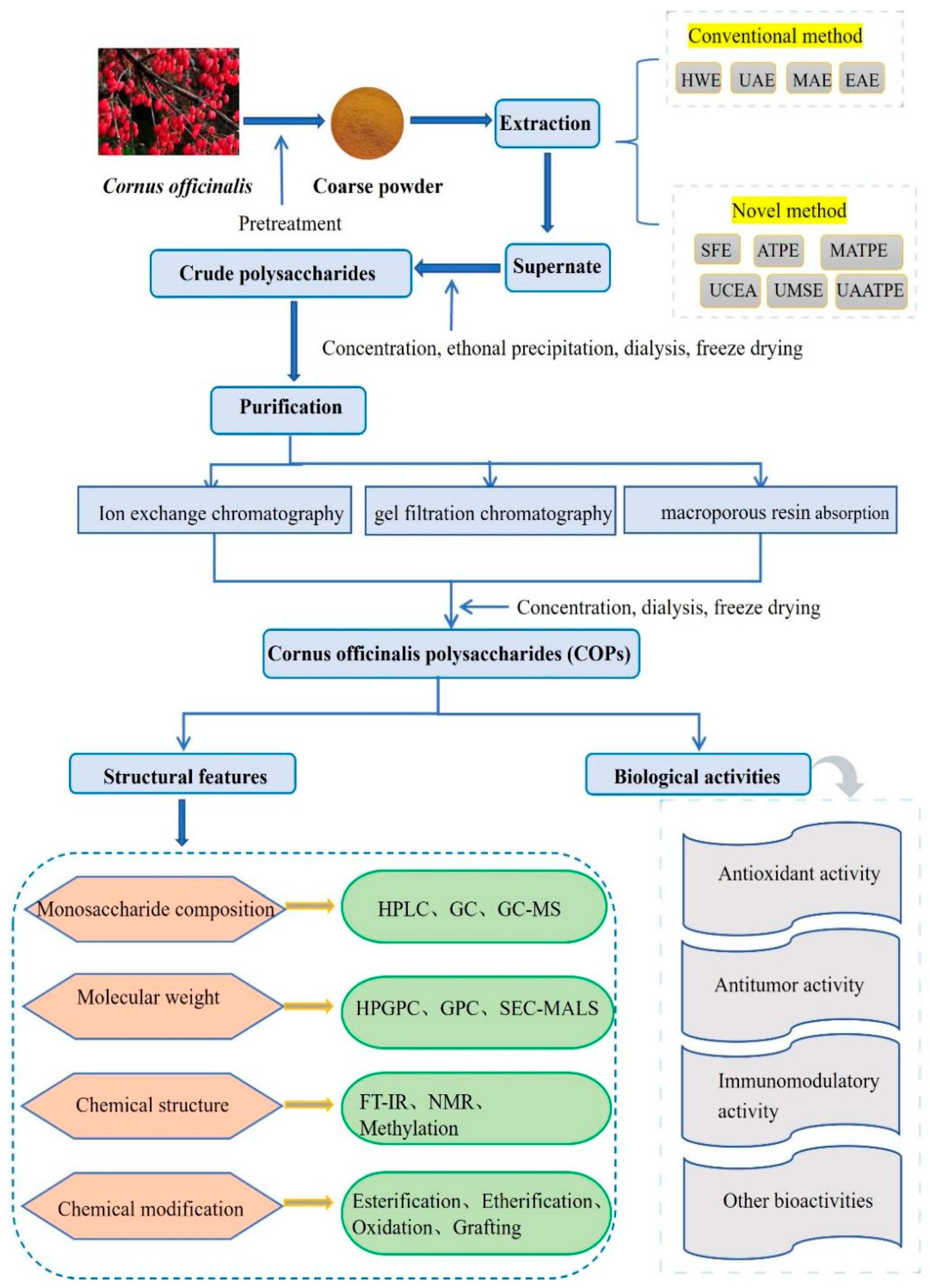

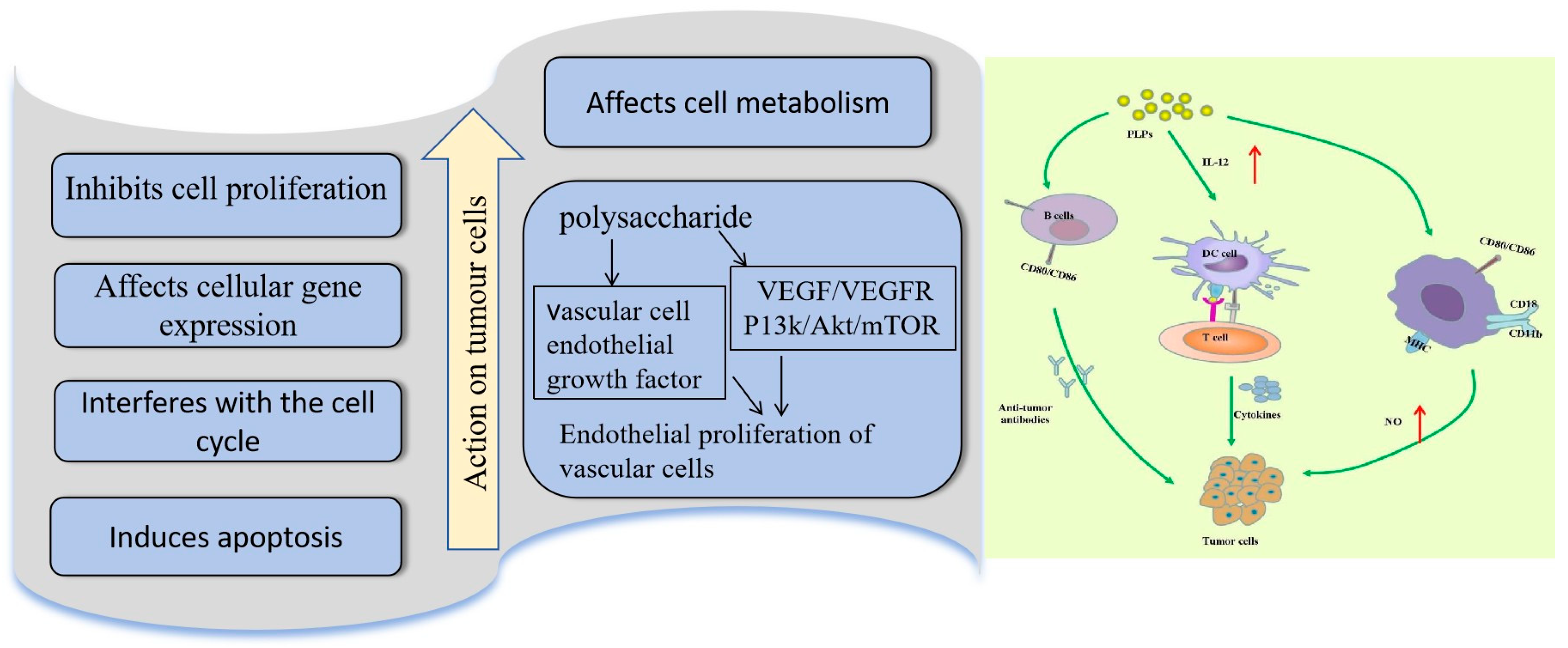
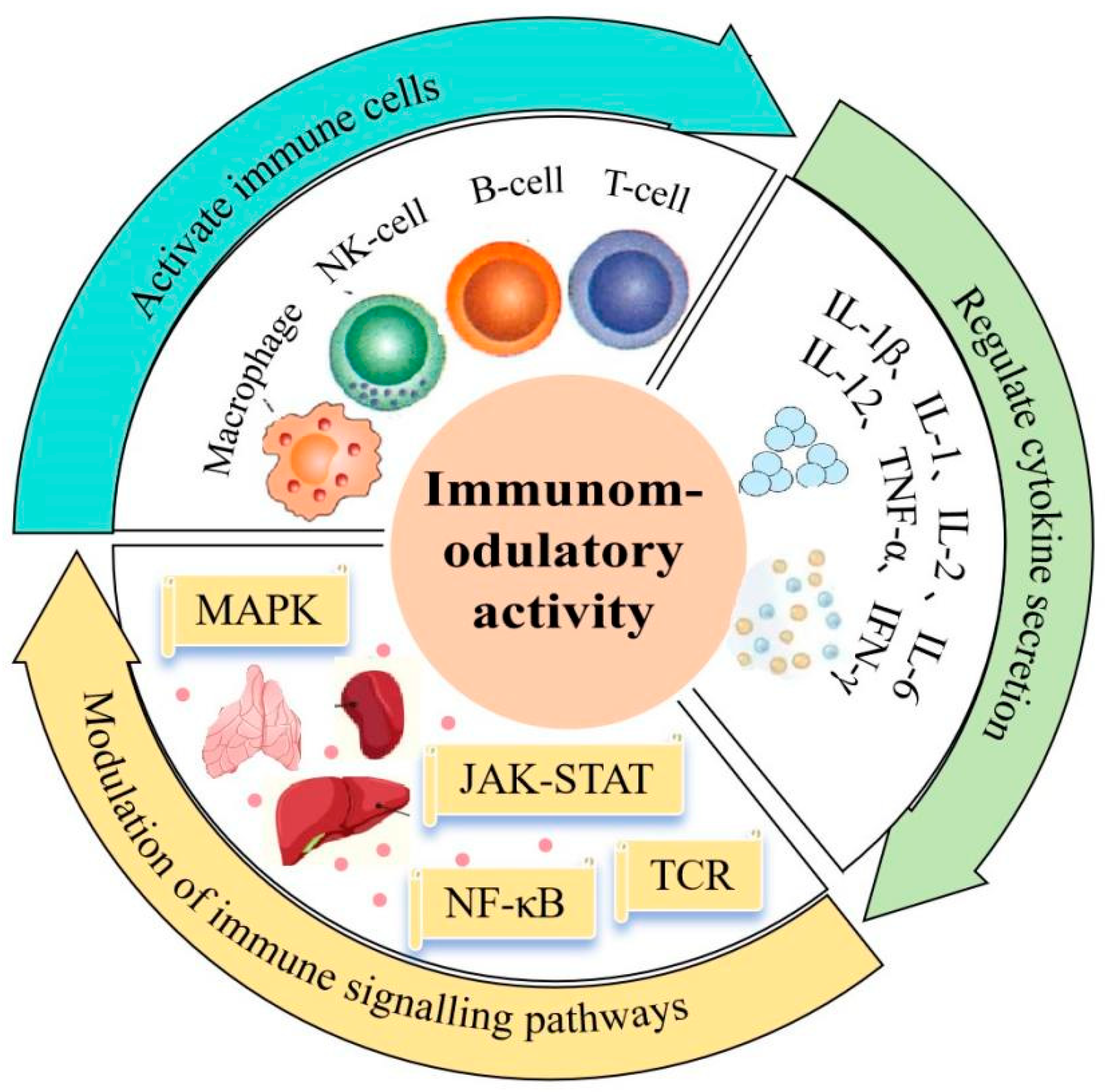
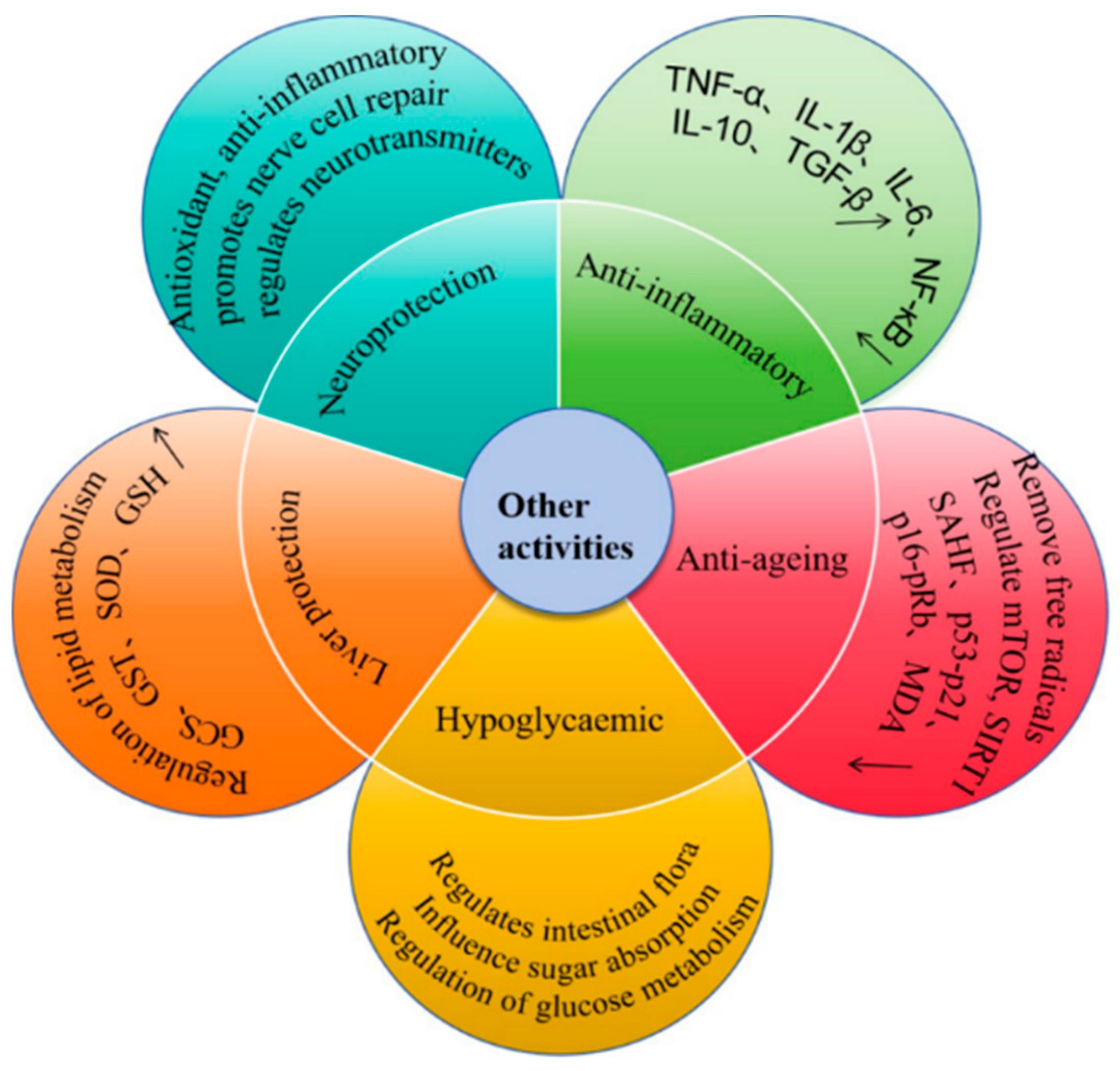
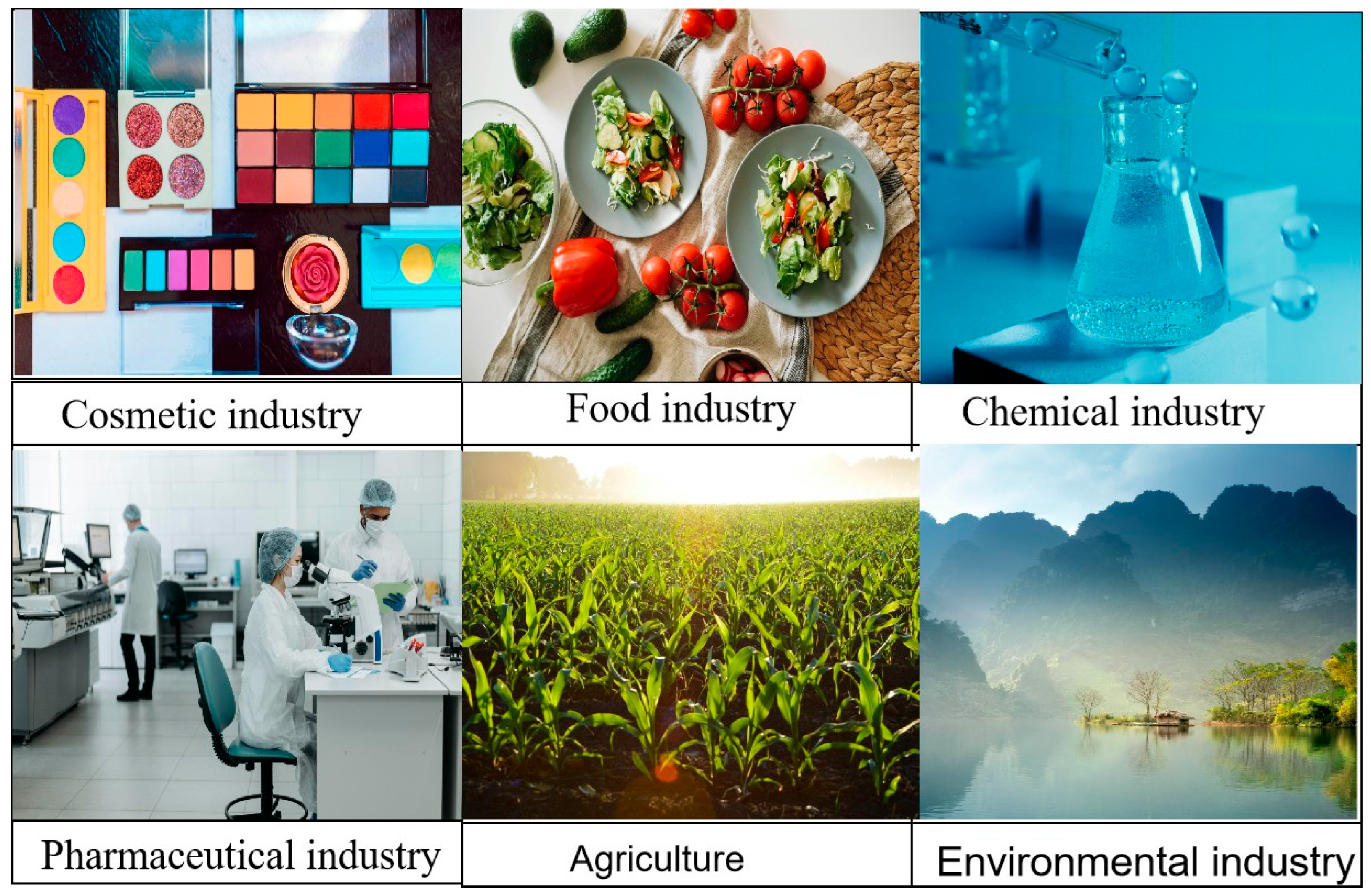
| Region | Species | Genus | Family | Region | Species | Genus | Family |
|---|---|---|---|---|---|---|---|
| Yunnan | 17 | 2 | 1 | Jiangsu | 6 | ||
| Guangxi | 12 | 2 | Anhui | 6 | |||
| Shanxi | 10 | 1 | Liaoning | 5 | |||
| Zhejiang | 10 | Hebei | 4 | 1 | |||
| Sichuan | 10 | Fujian | 4 | 1 | |||
| Henan | 9 | 1 | Taiwan | 4 | 1 | ||
| Guangdong | 9 | 1 | Xizang | 5 | |||
| Jiangxi | 9 | Jilin | 4 | ||||
| Gansu | 9 | 1 | Neimenggu | 3 | 1 | ||
| Guizhou | 8 | Qinghai | 2 | ||||
| Shanxi | 6 | 1 | Heilongjiang | 1 | |||
| Hunan | 7 | Xinjiang | 1 | ||||
| Hubei | 7 | Chongqing | 1 | ||||
| Hainan | 5 | 1 | 1 | Aomen | 1 | ||
| Shandong | 6 |
| Traditional Extraction Method | Advantage | Disadvantage | References |
|---|---|---|---|
| Hot water extraction | Easy and low-cost extraction | Low extraction rate | [15,24,25,26,27] |
| Acid (base) extraction | Applicable to specific polysaccharides | Possible damage to polysaccharide structure, complex processing, high equipment requirements | |
| Ultrasonic extraction | High extraction rate and simplicity | Glycosidic bond breaking by high ultrasound | |
| Microwave extraction | Time-saving, efficient, energy-saving | Solvent residue | |
| Enzyme extraction | Environmentally friendly and efficient | High environmental requirements, not for large-scale industrial production |
| Name | Structural Segment | References |
|---|---|---|
| APFC-2 |  | [51] |
| FCAP1 |  | [6] |
| PFC-3 | NM | [57] |
| Resource | Compound Name | Monosaccharide Composition | Molecular Mass (kDa) | Chemical Modification | DS | Effects | Reference |
|---|---|---|---|---|---|---|---|
| Zizania latifolia | ZLP | Ara, Gal, GlcUA, Xyl, GalU, Glc | 0.91–29.6 | DMF, SA | 15.1 ± 2.50 | Antioxidant | [65] |
| Dioscorea spp. | CYP | Rha, Gal, GlcA, Xyl, GalA, Glc | 333 | CSA-Pyr | 0.51 ± 0.05 | Immunity regulation | [66] |
| Taraxacum Mongolicum Hand.—Mazz | DRPs | Man, GlcN, Rha, Glc, Gal, Ara | NM | Concentrated sulfuric acid: n-butanol = 3:1 | 1.49 ± 0.07 | Glucose reduction, probiotic value-added, antioxidant | [67] |
| Medicago sativa L. | AP | Fuc, Ara, Gal, Glc, Xyl, GalU | 2.2 × 104 | CSA-Pyr | 0.724 | Antioxidant, antimicrobial | [68] |
| Leyss. ex Fr. | GLP | NM | 9.4 × 104–62.7 × 104 | SO3·Py | 0.83–1.74 | Bovine intestinal epithelial cell proliferation-promoting, anti-obesity, anticoagulation | [69] |
| Ginkgo biloba leaf | GBLP-3 | Man, Rha, Gal, GlcUA, Ara | NM | POCl3-Pyr | 0.228 | Antioxidant | [70] |
| Momordica charantia | Momordica charantia polysaccharide | Rha, GalUA, Gal, Xyl, Ara | NM | DMF, POCl3, Pyr | 0.12 ± 0.08 | Antioxidant | [71] |
| Trichosanthes peel | TPP-1 | NM | NM | (NaPO3)3, Na5P3O1, NaOH | 0.43 | Antioxidant | [72] |
| Garlic | Garlic polysaccharide | NM | NM | DMF, POCl3, C6H15N | 0.04 | Antioxidant | [73] |
| Pumpkin | Pumpkin polysaccharide | NM | NM | POCl3-Pyr | 0.01–0.02 | Antioxidant | [74] |
| Desmodium styracifolium | DSP0 | Glc, GalUA, Ara, Gal, Rha, Xyl, Man | 9.68 | C3H8O, NaOH, ClCH2COOH | NM | Antioxidant, repair damaged HK-2 cells, maintain cell physiology | [75] |
| Lotus root | LRP | GalUA, Glc, Gal, Ara, Man, Rib, Rha, GlcUA | NM | NaOH, ClCH2COOH | 0.309–0.514 | Antioxidant | [76] |
| Panax japonicus C. A. Mey | PJPS | Man, D-Rib, GlcUA, Gal, D-GalUA, Glc, | NM | NaOH, ClCH2COOH | 0.973 | Antioxidant | [77] |
| Orchis chusua D. Don (Salep) | SP | Glu, Man | 369 | C4H6O3, NaOH, NaHCO3, HCI | NM | Probiotic capacity, antioxidant | [78] |
| Garlic | PS | NM | NM | C4H6O3, NaOH, HCI | 0.5 | Antioxidant | [79] |
| Garcinia mangostana L. | UAEE-PMSP | Ara, Rha, GalUA | NM | C4H6O3, NaOH | 0.33 | Antioxidant | [80] |
| Lonicera caerulea L. fruits | PLP | GalA, Rha, Ara, Man, Glc, Gal | 5.9 × 104 | HNO3-Na2SeO3 | NM | Antioxidant | [81] |
| Dandelion roots | DRP | GalA, Rha, Ara, Man, Glc, Gal | 8.7 | HNO3-Na2SeO3 | Antioxidant, immunomodulation | [82] | |
| Medicago sativa L. | RAPS-1 RAPS-2 | Rha, Xyl, Ara, GalUA, Man, Glc | 10.0, 15.8 | HNO3-Na2SeO3 | Antioxidant, antitumor | [83] | |
| Green tea | TPS-1 | Rha, Ara, Gal, Glc, Xyl, Man, Fru, GaIA | NM | HNO3-Na2SeO3 | Glycosidase inhibitory activity | [84] |
Disclaimer/Publisher’s Note: The statements, opinions and data contained in all publications are solely those of the individual author(s) and contributor(s) and not of MDPI and/or the editor(s). MDPI and/or the editor(s) disclaim responsibility for any injury to people or property resulting from any ideas, methods, instructions or products referred to in the content. |
© 2025 by the authors. Licensee MDPI, Basel, Switzerland. This article is an open access article distributed under the terms and conditions of the Creative Commons Attribution (CC BY) license (https://creativecommons.org/licenses/by/4.0/).
Share and Cite
Wang, S.; Zhao, B.; Ma, X.; Zhang, J.; Li, G.; Li, M.; Liang, Q. Recent Advances in Polysaccharides from Cornus officinalis: Extraction, Purification, Structural Features, and Bioactivities. Foods 2025, 14, 1415. https://doi.org/10.3390/foods14081415
Wang S, Zhao B, Ma X, Zhang J, Li G, Li M, Liang Q. Recent Advances in Polysaccharides from Cornus officinalis: Extraction, Purification, Structural Features, and Bioactivities. Foods. 2025; 14(8):1415. https://doi.org/10.3390/foods14081415
Chicago/Turabian StyleWang, Shengfang, Baotang Zhao, Xuemei Ma, Jing Zhang, Guofeng Li, Mingze Li, and Qi Liang. 2025. "Recent Advances in Polysaccharides from Cornus officinalis: Extraction, Purification, Structural Features, and Bioactivities" Foods 14, no. 8: 1415. https://doi.org/10.3390/foods14081415
APA StyleWang, S., Zhao, B., Ma, X., Zhang, J., Li, G., Li, M., & Liang, Q. (2025). Recent Advances in Polysaccharides from Cornus officinalis: Extraction, Purification, Structural Features, and Bioactivities. Foods, 14(8), 1415. https://doi.org/10.3390/foods14081415





